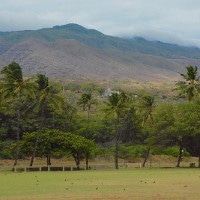Nov 13 2019
Many challenges face the storage of energy for extended periods. According to an IIASA scientist, a combination of Mountain Gravity Energy Storage (MGES) and hydropower could be a solution to overcome this challenge.
 Mountains rising above Molokai Island, Hawaii. Image Credit: © William Lee Bowman | Dreamstime)
Mountains rising above Molokai Island, Hawaii. Image Credit: © William Lee Bowman | Dreamstime)
Batteries are quickly becoming economical and might soon provide an inexpensive short-term solution for the storage of energy for day-to-day energy requirements. However, the capabilities of batteries to store energy for longer periods—for instance, in an annual cycle—will not be economically feasible.
Pumped-hydro storage (PHS) technologies are an economically viable choice for long-term energy storage with large capacities—more than 50 MW—but they become costly for areas where the demand for energy storage is generally lower than 20 MW with monthly or seasonal requirements, such as remote locations and small islands.
IIASA scientist Julian Hunt and his colleagues, in a paper published in the journal Energy, suggest the use of MGES to bridge the gap between current short and long-term storage technologies. MGES involves constructing cranes on the edge of a steep mountain with sufficient reach to transport sand (or gravel) from a storage location at the bottom to a storage location at the top.
A motor/generator transports storage vessels filled with sand from the bottom to the top, just like a ski lift. In the course of this process, potential energy storage takes place. Electricity is produced by lowering sand from the upper storage location back to the bottom.
In case river streams are present on the mountain, the MGES system can be integrated with hydropower, where the water would be used to fill the storage vessels, during times of high availability, rather than the sand or gravel, producing energy.
The advantage of the MGES systems is that the water could be added at any height of the system, enhancing the chances of catching water from various heights in the mountain, which cannot be done in traditional hydropower.
One of the benefits of this system is that sand is cheap and, unlike water, it does not evaporate—so you never lose potential energy and it can be reused innumerable times. This makes it particularly interesting for dry regions. Additionally, PHS plants are limited to a height difference of 1,200 meters, due to very high hydraulic pressures.
Julian Hunt, Researcher, IIASA
Hunt added, “MGES plants could have height differences of more than 5,000 meters. Regions with high mountains, for example, the Himalayas, Alps, and Rocky Mountains, could, therefore, become important long-term energy storage hubs. Other interesting locations for MGES are islands, such as Hawaii, Cape Verde, Madeira, and the Pacific Islands with steep mountainous terrain.”
In the paper, the researchers suggest a future energy matrix for the Molokai Island in Hawaii, which involves using only solar, wind, batteries, and MGES to supply the energy demand of the island. Hunt highlights that the MGES technology should not be used for peak generation or storing energy in everyday cycles—rather, it bridges a gap in the market for areas with long-term storage.
MGES systems can, for example, store energy non-stop for several months and then produce power continuously for months or when water is available for hydropower, while batteries handle the everyday storage cycles.
It is important to note that the MGES technology does not replace any current energy storage options but rather opens up new ways of storing energy and harnessing untapped hydropower potential in regions with high mountains.
Julian Hunt, Researcher, IIASA